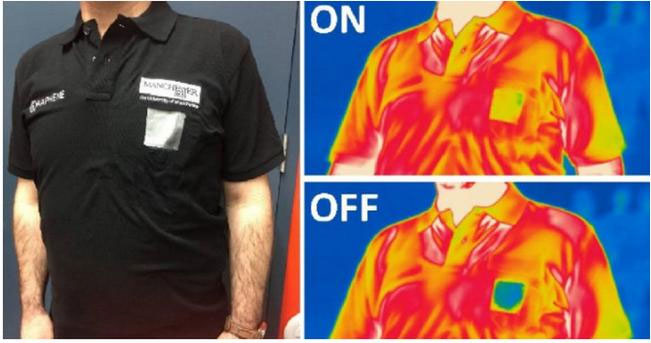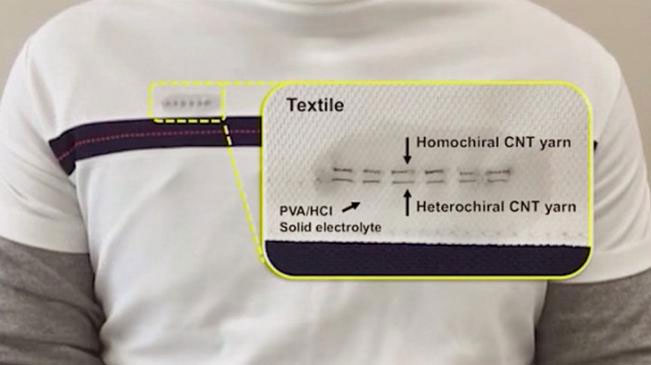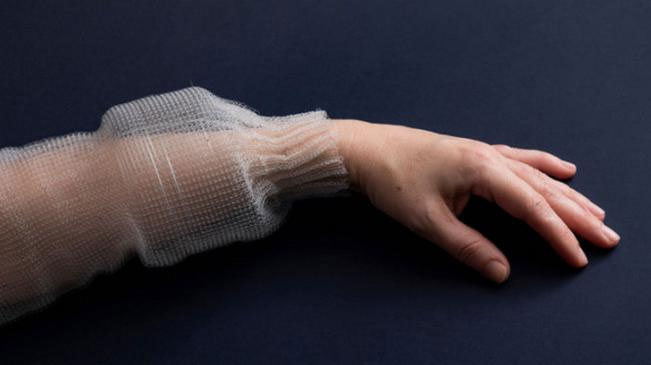This type of clothing seems to lean more towards specialized functions rather than enhancing human beauty.
Modern fabric production technologies include the development of smart clothing. These garments are supported by technology with capabilities such as changing colors, blocking sunlight, collecting health data, emitting vibrations, or even displaying customized notifications. Below, we will explore some of the most remarkable advancements in fabric technology, along with smart fabrics that are sure to amaze you.
Armor-Inspired Fabrics: An Exoskeleton
Hauberks, or chain mail, were once used in the Middle Ages, and many people surely think they are outdated. The answer is no. They have not disappeared; instead, they have transformed into another form in modern times. In 2021, engineers at the California Institute of Technology (Caltech) and Nanyang Technological University (NTU) in Singapore created a material with a chain-like structure that can switch from a soft to a hard state on command, capable of supporting a load 50 times its own weight when hardened.
To create this fabric, the research team layered hollow plastic or 3D-printed aluminum to interlock, allowing them to change shape while maintaining rigidity. While similar fabrics are adjusted by electromagnetic fields to contract or expand, chain fiber fabric uses a disruption conversion process, akin to the vacuum principle in a rice bag, hardening when air is sucked out, leaving no room for the rice particles to move. Chain fiber fabric can withstand a load of 2 pounds (about 1 kg) when stiffened.
“Granular materials will exemplify a complex system, meaning simple interactions will create different structures. In this application of chain fiber fabric, the large load capacity comes from the structure of the granules, demonstrating the element of situational change, where the ability to simulate complex behaviors will yield extraordinary designs different from these granular material models.”
Potential applications for this fabric include protective work armor, adaptive lung devices that change stiffness during patient recovery, roll-out and secure bridges, and an exoskeleton for protection, allowing individuals with mobility issues to walk normally.
Self-Cleaning Clothing
Scientists at the Royal Melbourne Institute of Technology in Australia have developed a self-cleaning fabric by “growing” nano structures of copper and silver on the cotton fibers of the fabric. The process of applying metal nano structures to woven fabric involves priming the cotton fabric with a tin chloride acid solution, then dipping the fabric into a palladium salt solution (a rare metal) to create self-forming particles on the fibers. Finally, the fabric is soaked in a solution containing copper and silver to create a photoactive metal nano structure.
The metal atoms of the nano structures react when exposed to light, thus when in contact with light, the fabric material decomposes organic compounds, self-cleaning stains and dirt within minutes. This invention could be significant for the agricultural chemicals or pharmaceutical industries; however, much work remains to improve the technique, especially to ensure these metal nano particles can be safely expelled, leading to environmental concerns. Additionally, silver nano particles have also been used to prevent odors by killing bacteria, but under certain conditions, they can also convert into toxic ions.
Fabrics That Cool the Body
Statistics show that the use of air conditioning and electric fans accounts for about 20% of total electricity consumption in buildings. So, can you imagine how much electricity could be saved if our bodies were regulated by the clothing we wear?
In 2020, a group of researchers from Stanford University (USA) and Nanjing University (China) attempted to modify several pieces of silk (a fabric that feels cool against the skin due to its reflective properties) to reflect up to 95% of sunlight, maintaining a temperature on the silk that is 3.5°C cooler than the surrounding air under the same sunlight conditions.

This fabric keeps the skin about 12.5°C cooler than cotton fabric.
The researchers successfully created this fabric by adding aluminum oxide nano particles to the silk fibers. These nano particles can reflect ultraviolet wavelengths of sunlight, keeping the skin about 12.5°C cooler than cotton fabric, an extremely effective cooling method.
The testing began with the use of simulated skin made from silicone, on which they placed the engineered silk, keeping the skin 8°C cooler under direct sunlight compared to natural silk. They then designed a long-sleeve shirt from technical silk and asked a volunteer to wear it and stand in the sun at a temperature of about 37°C, finding that the shirt did not warm up like natural silk or cotton fabric.
This silk shirt is not the first invention; earlier, a group of researchers from the National Graphene Institute at the University of Manchester also created a smart woven fabric for thermal adaptation by utilizing the infrared radiation of graphene (a form of carbon).
“The ability to control thermal radiation is essential when it comes to regulating body temperature in extremely high outdoor temperatures; thermal blankets are a common example for this purpose. However, maintaining these functions when the surrounding environment heats up or cools down is a significant challenge,” stated Professor Coskun Kocabas, the lead researcher at that time.
Energy-Harvesting Clothing
In 2016, researchers at the Georgia Institute of Technology in Atlanta created a fabric that harvests energy from both sunlight and motion energy. To create this fabric, the team wove together wool fibers, combined with photovoltaic cells made from lightweight polymer fibers and a triboelectric nano-generator based on optical fibers capable of generating a small amount of electrical power from mechanical movements. The fabric is about 320 micrometers thick, soft, breathable, and lightweight, and the inventors are very hopeful that it will be applied in tent models, curtains, and even clothing. We can even dream of a day when it will help us charge our phones while on the move.

To create this fabric, the team wove together wool fibers, combined with photovoltaic cells.
The grand goal is to harvest energy from our surrounding environment. This research has attracted attention as currently, small electronic devices with “mobility or wearability are rapidly developing, becoming more popular and fashionable, and they will require a power source to operate.”
Data-Storing Fibers That Detect Health Issues
Engineers at the Massachusetts Institute of Technology have developed a high-tech fiber that enables us to carry data within our clothing. This fiber is made from silicon chips electrically connected to each other, allowing them to store files for up to several months. These digital fibers act like sensors to monitor our physical activities, even capable of detecting illnesses in the body when combined with artificial neural networks. The neural network helps predict activities or body states, subsequently detecting early respiratory or health issues.

This fiber is made from silicon chips electrically connected to each other.
Biometric Monitoring Clothing
Fitness tracking wristwatches are not the only wearable devices that help monitor your activity, heart rate, and sleep habits. We are also familiar with clothing that can perform these functions through sensors. For example, a type of underwear designed by a textile company linked to an app can measure your body’s stress levels, rest times, or other options similar to wearable devices; it can also predict women’s ovulation cycles or health while driving.
In 2020, researchers at the Massachusetts Institute of Technology (MIT) developed a washable sensor capable of monitoring vital signs of the wearer, marking a revolution in the field of remote healthcare. Meanwhile, the Empa research center in Switzerland integrated optical fibers into their textiles to manage skin circulation issues, helping to prevent bedsores in comatose patients. Another company in Denmark designed a special type of sock that detects abnormal issues in the feet, which is particularly useful for patients with potential blood clotting problems in their legs.
Smart clothing applications have emerged, and the future promises even more innovations. Although these technologies have yet to become mainstream, there is hope that one day we will completely revolutionize the way we dress.
- Climbing trees to catch macaques, the leopard cat is knocked down after being chased away
- Fiercely hunting antelopes, the lion is left “between life and death” but refuses to let go of its prey
- A plane accidentally breaking the sound barrier causes panic among residents who mistake it for an earthquake


















































